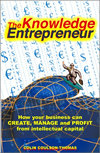 |
 |
|
 |
Managing Supply Chain Relationships
By Professor
Colin Coulson-Thomas
How effective are you at working with other
businesses? Should you be learning to collaborate as well as compete?
Early industrial tycoons used to grow their firms by ‘integrating
along the supply chain’ or grabbing more of what other companies
did. Some verged on megalomania and aspired to take over just about anything
that moved.
Today’s commercial world is very different. Customers and investors
look for ‘focus’. They expect businesses to concentrate upon
what they do best. Non-core activities are outsourced. Firms that spread
themselves too thinly risk becoming ‘Jack of all trades and master
of none’.
Customers are also more demanding. They want the best. The emphasis has
switched to differentiation and specialisation, doing a smaller number
of things supremely well and developing a reputation for excellence in
a particular field.
In business, sport and the arts an ever-higher share of the available
rewards accrue to those who are outstanding. Average performers are marginalized
while the super-stars clean up. As markets become more complex and competitive
there are just not enough hours in the day to keep up with everything.
Inevitably these developments mean we have to change how we operate. We
can no longer afford to keep to ourselves or go it alone. A greater proportion
of the value consumed by end customers is now delivered by collective
endeavours.
Co-operation with other firms enables businesses to broaden offerings
with complementary products, add services to justify premium prices or
reach new customers. Like it or not, companies have to work ever more
closely with business partners. In many markets good supply chain relationships
are a critical success factor.
The reputations of brands reflect customers’ total experience. A
failing at one point can undermine excellence elsewhere. Hence, the importance
of working together to ensure consistency of service and create a positive
spiral of mutual re-enforcement.
Managing supply chain relationships should be high on the entrepreneur’s
agenda. An investigation* reveals that visionaries use them to create
new business opportunities while competitors wedded to existing practices
go under. They reshape their organisations, introduce new channels and
establish new markets through more intimate relationships with customers,
suppliers and business partners.
Despite the opportunities many businesses lack ambition. They tinker with
existing processes and adopt me-too practices rather than innovate. The
creativity displayed when crafting new offerings is not matched by similar
imagination when they consider how to get these into the hands of customers.
Of course change for its own sake should be avoided. It can be disruptive
of existing relationships while new ones take time and effort to establish.
Significant change should be for a strategic purpose, and one that can
be shared by supply chain partners. The focus should be upon the customer,
for example offering them additional choice or more tailored products
and services.
Providing alternatives to existing provision can help to differentiate
a business from its competitors. If more customers demand distinct or
bespoke offerings supply chain partners must deliver greater variety at
lower costs and more quickly. Ways of reducing waiting time might range
from joint R&D and taskforces to seamless processes and direct electronic
links.
On-line ordering, just-in-time responses, the ability to track orders
and ‘help-desk’ support can all help to lock customers in.
Maybe invoices and reports could be delivered electronically in formats
to suit individual customers. Contracted in experts might be able to provide
additional specialist services.
Collaboration can speed up international expansion. For example, it is
difficult to become a global software player without a strong market position
in North America. A local presence may be required. This might involve
giving further percentages to yet more partners, but the smaller proportion
retained may be of much larger income streams.
Micro-businesses - even individual craft workers in
the jungle – can reach a global clientele via the Internet. Working
with website management, transaction processing, fulfilment and debt collection
partners frees them from the distractions of hiring people, finding premises
and putting support processes in place. Instead, they concentrate upon
their individual passions and play to their particular strengths.
Innovators create new ways of doing businesses and additional routes to
potential customers. Maybe airline passengers and travellers on intercity
train could order goods from an electronic catalogue and pick them up
on arrival at their destinations. People could collect items selected
on an office PC from reception when they leave to go home.
A particular role within a supply chain may both create a new source of
competitive advantage and represent a wider business opportunity. For
example, a service such as handling warranty repairs could be opened up
to suppliers of non-competing products. A further partner could be brought
in to run an interest group or offer end customers discounts on related
items.
So long as rewards exceed costs and image and reputation are enhanced
rather than compromised additional service providers can improve the competitive
positioning of a supply chain. Yet few such groupings manage their affairs
as a whole and actively seek new members, even though competition is increasingly
between networks of collaborating partners rather than individual companies.
Some companies develop multiple supply chains as they further segment
their customers and diversify their channels to market. Each additional
relationship can complicate the task of securing agreement. Supply chains
can fragment as well as coalesce. Participants need to be alert to potential
fissures and forces for fragmentation.
Particular partners may seek to cut out intermediaries and secure a more
direct route to an end-customer, perhaps via e-business over the Internet.
Others may review their core competencies and consolidate their relationships.
A whole network might be made redundant by the replacement of a physical
market place by an electronic market space.
Supply chains do not obviate the search for advantage and profit. Today’s
collaborator may become tomorrow’s competitor. Relationships should
be regularly reviewed. Are they meeting end customer needs? Do they enable
participants to specialise and build up their core skills?
Inevitably differences will arise. The trick is not to avoid or ignore
them. Frustration, misunderstanding and resentment may build to a level
that alienates one or more business partners. The whole chain is only
as effective as it weakest link. A low-level dispute resolution process
should be put in place to tackle issues before they escalate and entrenched
positions are taken.
Companies should be realistic about the value of their own contribution
within a supply chain. Is it visible to end customers? How might their
changing requirements, emerging trends and new technologies affect it?
New attitudes, skills and capabilities may be required to deal with future
challenges.
Particular attention should be paid to the likely impact of economic cycles
and technological developments with the potential to change the shape
of markets and create new ones. Businesses need to think about the implications
for their relationships with supply chain partners and any new ground
rules that are likely to apply.
Smart entrepreneurs build partnering relationships with both customers
and suppliers. They start with requirements, what end-customers would
really like. They identify gaps in their own capabilities and their partners’
collective capacity to deliver. While acknowledging their deficiencies
they do not loose sleep over them. Instead they cooperate with complementary
providers of whatever they lack.
Cooperation with others may involve letting go of certain activities and
possibilities. This can be difficult for entrepreneurs who feel they are
losing part of ‘their’ opportunity.
In reality, many business founders soon face pressure from investors to
be ‘true to themselves’. They are asked to focus upon their
unique qualities and personal strengths and bring in people with complementary
skills, or even hand over the reigns to professional managers. In essence,
putting new supply chain relationships in place is specialisation at the
enterprise level.
When they negotiate effective collaborators flush out the key business
objectives of the various parties involved and agree ‘win-win’
outcomes that are mutually beneficial to all concerned. Relationships
that are too one-sided do not stand the test of time.
If cost savings and productivity gains are shared business partners have
more of an incentive to work together. It is usually to everyone’s
advantage to act in the best interests of a supply chain as a whole. It
may be helpful for the parties to formally contract to achieve certain
targeted improvements over time.
Resilient relationships are based upon openness and trust. This may extend
to open book accounting to dispel suspicions of ‘excess profits’.
Everybody usually benefits if all business partners do well. The attention
of parties that secure inadequate returns may wander. Collective success
can generate the funds to invest in technology upgrades and other means
of securing continuing competitive advantage.
© Colin Coulson-Thomas, 2005

Professor Colin Coulson-Thomas |
About the Author:
Prof. Colin Coulson-Thomas, an experienced company chairman, has
advised over 90 boards and management teams on director, board and
corporate development. Formerly the world’s first Professor
of Corporate Transformation and Process Vision Holder of major transformation
projects, he is the UK’s first Professor of Competitiveness
and can be contacted:
Tel: 01733 361 149
Fax: 01733 361 459
Email: colinct@tiscali.co.uk
Web: www.ntwkfirm.com/colin.coulson-thomas
*‘Transforming the Company, Manage Change, Compete and Win’
by Colin Coulson-Thomas and published by Kogan Page can be ordered
by Tel. 01903 828800; Fax. 020 7837 6348; E-mail: orders@lbsltd.co.uk
or on-line at www.kogan-page.co.uk
or www.ntwkfirm.com/bookshop
|
|
Transforming the Company: Manage Change, Compete & Win
Colin Coulson-Thomas shows that to bridge the gap between rhetoric
and reality, business people must make far-reaching decisions about
the value to them and their companies of particular theories, past
assumptions and traditional approaches. Based on original research,
the first edition of this was ahead of its time and predicted many
of the current management trends. The author now brings the text bang
up-to-date for the 21st century. This second edition of Transforming
The Company shows how to turn theory into practice by highlighting
the obstacles and barriers that confront companies when trying to
bring about change. For management at all levels faced with this task,
this thought-provoking book will inspire and enlighten. |
| 
Buy
UK Buy
US
|
The Knowledge Entrepreneur: How Your Business Can Create,
Manage and Profit from Intellectual Capital
In many companies knowledge management has focused almost exclusively
upon the packaging of existing knowledge. This book is designed
to help readers boost revenues and profit by significantly improving
the performance of existing activities and also creating new offerings
that generate additional income. It shows how practical knowledge-based
job-support tools can transform work group productivity, and reveals
the enormous scope for addressing contemporary problems such as
"information overload" with imaginative responses. Additional
information includes: a list of possible commercial ventures; detailed
checklists that can be used for identifying and analysing opportunities
for knowledge entrepreneurship; and exercises for assessing entrepreneurial
potential and "scoping" possible products and services.
The free CD-ROM packaged with the book gives examples of particular
knowledge-based job support tools that have dramatically improved
desired results in crucial areas such as winning more business.
|

top of page |
 |
